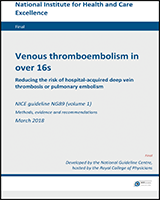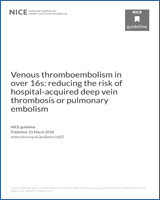NCBI Bookshelf. A service of the National Library of Medicine, National Institutes of Health.
National Guideline Centre (UK). Venous thromboembolism in over 16s: Reducing the risk of hospital-acquired deep vein thrombosis or pulmonary embolism. London: National Institute for Health and Care Excellence (NICE); 2018 Mar. (NICE Guideline, No. 89.)
December 2019: In recommendation 1.3.5 the British Standards for anti-embolism hosiery were updated because BS 6612 and BS 7672 have been withdrawn. August 2019: Recommendation 1.12.11 (1.5.30 in this document) was amended to clarify when anti-embolism stockings can be used for VTE prophylaxis for people with spinal injury.

Venous thromboembolism in over 16s: Reducing the risk of hospital-acquired deep vein thrombosis or pulmonary embolism.
Show details29.1. Introduction
The risk of VTE in the foot and ankle surgery population is heterogeneous. However, there are several known risk factors that can increase the risk of VTE, including type and duration of surgery and period of immobilisation. Some patients who have foot or ankle surgery may be immobilised and require the use of a plaster cast or orthosis; these patients are evaluated in the lower limb immobilisation review (chapter 24). This guidance is for the totality of patients treated with lower limb immobilisation; clinicians should consider individual patient risk, such as people with tendoachilles rupture, when determining which VTE prophylaxis intervention is appropriate for a patient.
29.2. Review question: What is the effectiveness of different pharmacological and mechanical prophylaxis strategies (alone or in combination) in people having foot and ankle surgery?
For full details see review protocol in appendix C.
Table 130
PICO characteristics of review question.
29.3. Clinical evidence
No relevant clinical studies comparing different pharmacological and mechanical prophylaxis strategies for people who are undergoing foot and ankle surgery were identified. See the study selection flow chart in appendix E and excluded studies list in appendix N.
29.4. Economic evidence
Published literature
No relevant health economic studies were identified.
See also the health economic study selection flow chart in appendix F.
29.5. Evidence statements
Clinical
No relevant clinical studies were identified.
Economic
No relevant economic evaluations were identified.
29.6. Recommendations and link to evidence
| Recommendations |
|
| Research recommendation | None |
| Relative values of different outcomes |
The committee considered all-cause mortality (up to 90 days from hospital discharge), deep vein thrombosis (symptomatic and asymptomatic) (up to 90 days from hospital discharge), pulmonary embolism (up to 90 days from hospital discharge), fatal PE (up to 90 days from hospital discharge), and major bleeding (up to 45 days from hospital discharge) as critical outcomes. The committee considered clinically relevant non-major bleeding (up to 45 days from hospital discharge), health-related quality of life (up to 90 days from hospital discharge), heparin-induced thrombocytopaenia (duration of study), and technical complications of mechanical interventions (duration of study) as important outcomes. Please see section 4.4.3 in the methods chapter for further detail on prioritisation of the critical outcomes. |
| Quality of the clinical evidence | No clinical evidence was identified for inclusion in this review. |
| Trade-off between clinical benefits and harms |
In the absence of any clinical evidence, the committee considered advice from the orthopaedic subgroup and discussed that for those undergoing foot and ankle surgery, prophylaxis is not indicated for those whose surgery lasts less than 90 minutes, are not subsequently immobilised and are assessed as low risk for VTE. Where patients are immobilised after their foot or ankle surgery the risk of VTE is the same as the population reviewed for lower limb immobilisation and therefore the same recommendations apply, including the consideration of stopping prophylaxis if immobilisation continues after 42 days. |
| Trade-off between net clinical effects and costs |
No relevant economic studies were identified for this population. Relevant unit costs were presented to the committee. The committee acknowledged that the risk of VTE will be minimal if the surgery total anaesthesia time is less than 90 minutes and the person undergoing the surgery has been assessed to be at low risk of VTE. This means that provision of prophylaxis for this group is unlikely to be cost-effective. Where immobilisation is required the risk of VTE will be higher, which would justify the cost of provision of prophylaxis. For this group, LMWH has been recommended based on the evidence considered specifically for people discharged with lower limb immobilisation in a separate chapter in this update. This was also reported to be in line with current practice. The committee acknowledged that long durations of immobilisation in this population are unlikely; however, the decision to continue prophylaxis beyond 6 weeks (42 days) should be made based on the balance between VTE and bleeding risks. |
| Other considerations |
The ‘consider’ recommendation is a reflection of the lack of evidence in this population. However, it is the committee’s view that for this group of patients, prophylaxis is likely to be most clinically and cost effective when immobilisation is required or anaesthesia time is longer than one hour. The committee noted that not all patients who receive lower limb immobilisation are orthopaedic patients; for example, some patients with diabetic foot also receive immobilisation. This group of patients is also included in these recommendations. |
- Foot and ankle orthopaedic surgery - Venous thromboembolism in over 16sFoot and ankle orthopaedic surgery - Venous thromboembolism in over 16s
Your browsing activity is empty.
Activity recording is turned off.
See more...
